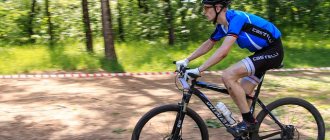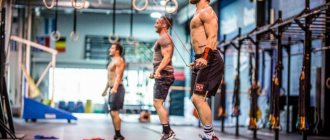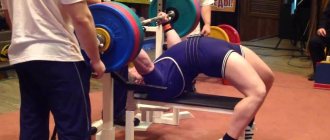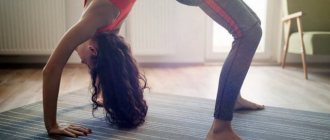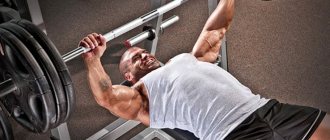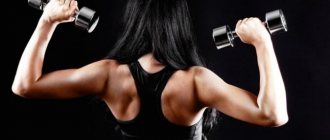Methods for express assessment of the level of physical condition of people[edit | edit code]
Source: “Sports Medicine”
Author:
Ed. S.P. Mironova, 2013
A number of authors have proposed formalized (in points) methods for rapid assessment of physical fitness based on the simplest clinical and physiological indicators, which have fairly high correlations with the level of an individual’s aerobic energy potential. In particular, several diagnostic systems have been created for primary (“Contrex-3”), current (“Contrex-2”) control and self-monitoring (“Contrex-1”).
Indicators for determining the level of physical condition according to the Kontrex-2 system.
- Age. Each year of life gives one point.
- Body mass. Normal body weight is estimated at 30 points. For every kilogram over the norm, 5 points are deducted.
- The normal body weight
is determined by the formula: men: 50 + (body length - 150) x 0.75 + (age - 21)/4; - women: 50 + (body length - 150) x 0.32 + (age - 21)/5.
- Arterial pressure.
Normal blood pressure is estimated at 30 points. For every 5 mm Hg. systolic or diastolic pressure above the calculated values, 6 points are subtracted from the total amount.
- Proper blood pressure
is determined by the formula: men: blood pressure syst. = 109 + 0.5 x age + 0.1 x body weight; - BP diast. = 74 + 0.1 x age + 0.15 x body weight;
- BP syst. = 102 + 0.7 x age + 0.15 x body weight;
- Pulse at rest.
For each beat less than 90, 1 point is awarded (a pulse of 70 beats gives 20 points). No points are awarded for a pulse of 90 beats or higher.
- Flexibility.
Standing on a step with legs straightened at the knees, the subject bends forward while maintaining the pose for at least 2 s. Each centimeter below the zero point (it is at the level of the feet) is scored 1 point. If the subject does not reach the zero mark, no point is awarded.
- Rapidity.
The test is performed in a standing position. The assistant takes a ruler 40 cm long and places it at a distance of 1-2 cm from the palm of the subject’s outstretched hand. The zero mark of the ruler should be at the level of the lower edge of the palm. After the “Attention” command, the assistant must lower the ruler within 5 seconds. The test subject is faced with the task of clenching his fingers into a fist and grabbing a ruler as quickly as possible. Measure the distance in centimeters from the bottom edge of the palm to the zero mark. The test is carried out 3 times, the best result is selected. For each centimeter equal to the age norm or less, 2 points are awarded (for example, a man aged 50 years has a result of 17 cm. He receives 10 points - 2 for meeting the norm and 8 points for exceeding the norm).
- Dynamic force.
Estimate the maximum height of a standing jump. For every centimeter exceeding the standard value, 2 points are awarded. Performing the test: a measuring tape (student's ruler 1 m long) is attached to the wall. Without lifting his heels, the subject raises his hand up and touches the ruler as high as possible (make a mark of the level of contact), then, moving 15-30 cm from the wall, he must jump up, pushing off with both legs, and touch the ruler again. The difference between the values of the first and second touch characterizes the height of the jump. Of the three attempts, the best one is counted.
- Speed endurance.
Calculate the maximum frequency of raising straight legs to an angle of 90? from a supine position in 20 s. For each lift equal to or exceeding the standard value, 3 points are awarded.
- Speed-strength endurance.
The maximum frequency of arm flexion is measured (in a lying position for men, in a kneeling position for women) for 30 s. For each bend equal to or exceeding the standard, 4 points are awarded.
- General endurance.
People who have started physical exercise and have been doing it for no more than 6 weeks can use the following gradation. If a person performs endurance exercise (running, swimming, skiing or skating, rowing, cycling) 5 times a week for 15 minutes, he receives 30 points, 4 times a week - 25 points, 3 times a week - 20 points, 2 times - 10 points, 1 time - 5 points, none - 0 points. The load should be performed at a pulse of at least 170 beats/min minus age in years and no more than 185 beats/min minus age in years. After 6 weeks of physical exercise, general endurance is assessed by running as far as possible for 10 minutes. For fulfilling the standard, 30 points are awarded and for every 50 m of distance exceeding this value - 15 points. For every 50 m of distance less than the age standard, 5 are subtracted from 30 points. The minimum number of points scored on this test is 0. The test is recommended for independent physical education. In a group form of training, general endurance is assessed using races over a distance of 2000 m for men and 1700 m for women. Standard time serves as control. For fulfilling the standard, 30 points are awarded and for every 10 seconds less than this value - 15 points. For every 10 seconds more than the standard, 5 are subtracted from 30 points. The minimum number of points for the test is 0.
- Pulse recovery
. For those starting classes, after 5 minutes of rest in a sitting position, the pulse is measured for 1 minute, then they are asked to do 20 squats in 40 seconds, after which, at the end of 2 minutes of recovery, their heart rate is again recorded. The resulting value is multiplied by 6. If the pulse returns to its original value, the subject receives 30 points, an excess of the pulse by 10 beats - 20 points, by 15 - 10 points, by 20 - 5 points, more than 20 beats - 10 points should be subtracted from the total amount. After 6 weeks of training, heart rate recovery is assessed 10 minutes after the end of a 10-minute run or a run over a distance of 2000 m for men and 1700 m for women by comparing the heart rate after running with the initial value. Their coincidence gives 30 points, exceeding up to 10 hits - 20 points, 15 hits - 10 points, more than 20 hits - 10 points should be subtracted from the total amount.
Assessment of the level of physical fitness using the Kontrex-2
carried out as follows.
After summing up the points obtained for all 11 indicators, the physical condition is assessed as low - less than 50 points, below average - 51-90 points, average - 91-160 points, above average - 160-250 points, high - more than 250 points.
Diagnostic system "Kontrex-3"
includes, in addition to the listed indicators of the Kontrex-2 system, an ECG assessment. With a normal ECG at rest and the absence of pathological changes during a 2-minute test with hyperventilation, the subject receives 30 points. If one of the signs of inadequacy is detected by the ECG, 10 points are subtracted from the total amount, and for each subsequent sign - 5 points.
System "Kontrex-1"
is based on risk factors for the development of coronary artery disease and consists of eight indicators: age, body weight, blood pressure and heart rate at rest, heart rate recovery after exercise, general endurance, smoking and alcohol intake. A non-smoker gets 30 points. For each cigarette smoked during the day, 1 point is deducted from the total. A person who does not drink alcohol gets 30 points. For every 100 ml of any alcoholic drink consumed at least once a week, 2 points are deducted from the accumulated amount. Occasional alcohol intake is not taken into account.
Principles for assessing the level of physical fitness using the Kontrex-1 system:
- low - <90;
- below average - 91-120;
- average - 121-170;
- above average - 171-200;
- high - >201.
In addition to those described above, there are a number of other express methods for assessing the level of physical condition of people who engage in recreational physical education. In particular, such methods include the G.L. system. Apanasenko and R.G. Naumenko (Table 1).
You are able to run 2.5 - 3 km.
Doesn't that sound too tempting? Special forces soldiers run 3 or 5 km a couple of times a week and 10 km about once a month, with an additional weight of 12 kg and breathing only through the nose.
If you find it difficult to run three kilometers, don't worry - it can be trained. Run less, but gradually increase the distance and speed.
And don't forget about the importance of changing your workouts, for example, you can switch to cycling or swimming (a less traumatic activity that is suitable for everyone, especially older people for whom running can cause pain in the legs and in particular in the knees).
Here's a chart that will help you check your physique based on a 2.5K run. The more time you have to run, the more you should train.
Strength check[edit | edit code]
| Source: Fitness for Beginners . Manual, 3rd ed. Author: Liz Neporent, 2017 |
From time to time, you just need to put your overall fitness, including strength, to the test. Strength tests are especially important if you have just decided to take up strength training. You need to know your starting point so you can set realistic goals and develop a training program that reflects your current capabilities. As you get stronger, periodic strength testing will help measure your progress and keep you motivated to train. It's true that some people are more numbers-oriented than others, so the frequency of progress tracking usually varies from person to person. Some people are satisfied with just recording the details of their workouts every day; For others, annual tests provide sufficient motivation.
Testing strength and endurance[edit | edit code]
When starting a strength training program, you should test more than just the strength of your muscles. It is also important to evaluate your flexibility and cardiovascular fitness (on an exercise bike or treadmill). Instead of just a strength review, these additional assessments will give you a more complete picture of your overall fitness. So, before you start strength training, write down the following information about yourself in your diary:
- height;
- weight;
- resting heart rate;
- blood pressure;
- blood cholesterol levels;
- Waist;
- body structure;
- body mass index;
- blood sugar level.
All of these factors are important metabolic indicators of your overall health. Recording the information above will help you track your progress throughout your workouts. It will allow you to clearly see the results, even when it seems to you that the change in waist size or the increase in biceps is not happening very quickly. In general, by consistently following a strength training program, you are sure to see improvements in three areas:
- body structure;
- body mass index;
- blood pressure.
Collectively, these improvements reflect your overall health. Most fitness centers offer assessments of their members' overall fitness for a reasonable fee. Some clubs even include this evaluation as part of the service package for new members.
Research shows that staying in shape to reduce your risk of disease and improve your quality of life is more important than simply losing weight. An example is a remarkable study conducted at the Cooper Research Institute. The overweight, physically fit people who took part in the study showed a lower risk of disease and more vitality than those who were slim but inactive.
Term test of strength
is not entirely correct.
Essentially, your strength
comes down to the maximum amount of weight you can lift at one time.
This is sometimes also called a one-repetition maximum
. For example, if you shoulder press no more than 20 kg, that would be your one-repetition maximum for that exercise. In principle, going by measuring these maxima is not such a good idea, especially if you are new to strength training. Yes, some experienced athletes sometimes practice it, but usually they record only one or two maximums during the entire workout. Lifting as much weight as possible puts a lot of stress on your body and can cause severe muscle pain even in veteran weightlifters.
A safe alternative to testing general muscle strength is to test your muscular endurance
. This variation uses a weight lighter than your maximum and performs as many reps as you can. Today, this type of testing is practiced in most sports clubs, although you can use it to test your muscle endurance at home.
In table 1 provides a list of exercises that can be used to test the endurance of each muscle group. The results will give you a simple and clear starting point. Once you start lifting weights regularly, your strength will increase very quickly.
Naturally, it is not possible to name a universal weight used for strength tests since all people have different abilities. But here's a helpful tip: choose a weight for each exercise that you think you can lift at least six times. If even after six repetitions it seems too easy, put it aside and rest for a couple of minutes. Then try a weight a couple of kilograms heavier.
For exercises that don't use a weight—like crunches and push-ups—just do as many reps as you can.
Table 1. Sample exercises for assessing strength
| Part of the body | Free weights | Use of simulators |
| Buttocks and legs | Squats | Leg press on the machine |
| Front of thighs | Seated leg press | Leg extension on the simulator |
| Back of thighs | Leg bending while on all fours | Leg bending while lying on the machine |
| Shin | Standing toe raise | Working on a calf machine |
| Upper back | One-arm dumbbell row | High block row |
| Lower back | Back extension | Back extension on the machine |
| Breast | Push ups | Chest press on the machine |
| Shoulders | Dumbbell Shoulder Press | Shoulder press on the machine |
| Biceps | Dumbbell Curl | Bending arms on the simulator |
| Triceps | Bench push-ups | Press down on the machine |
| Stomach | Abdominal twist | Without simulators |
Before you begin testing your strength, create a diagram of the body parts you want to test. Next to each of them, note which exercise you performed, how much weight you lifted and how many repetitions you were able to do. Be sure to put a date on the diagram. Create a special folder for this data on your computer or record it directly in your training log. Use your findings to develop a strength training program that will help you achieve your goals.
Upper body strength[edit | edit code]
Being able to compare your results to other people who take similar tests can motivate you to work harder. A popular test to test upper back strength is to count the number of push-ups a person can do. Men usually do special military push-ups in this test, while women do slightly modified ones. The point is to do as many push-ups as possible before you can no longer do any properly. The best way to pass this test is to have a friend, family member, or training partner count the number of repetitions out loud. Be sure to write down the date and the resulting number in your diary. The table will help you compare your push-up results with the standard successes of other people. 2 and 3.
Table 2. Push-ups for men
| Age | 20-29 | 30-39 | 40-49 | 50-59 | 60+ |
| Wonderful | 55+ | 45+ | 40+ | 35+ | 30+ |
| Fine | 45-54 | 35-44 | 30-39 | 25-34 | 20-29 |
| Average | 35-44 | 35-34 | 20-29 | 15-24 | 10-19 |
| So-so | 20-34 | 15-24 | 12-19 | 8-14 | 5-9 |
| Weak | 0-19 | 0-14 | 0-11 | 0-71 | 0-4 |
Table 3. Push-ups for women
| Age: | 20-29 | 30-39 | 40-49 | 50-59 | 60+ |
| Wonderful | 49+ | 40+ | 35+ | 30+ | 20+ |
| Fine | 34-48 | 25-39 | 20-34 | 15-29 | 5-19 |
| Average | 17-33 | 12-24 | 8-19 | 6-14 | 3-4 |
| So-so | 6-16 | 4-11 | 3-7 | 2-5 | 1-2 |
| Weak | 0-5 | 0-3 | 0-2 | 0-1 | 0 |
Abdominal muscle strength[edit | edit code]
Abdominal twist
is another popular assessment method that can easily be used even at home, in the company of a friend, family member or training partner. Lie on your back on the training mat with your knees bent and your arms extended along your body, palms down. Have your partner use duct tape to draw a horizontal line on each side of your body at your fingertips. Another piece of tape should be placed parallel to the first, closer to your feet by about 6 cm.
To begin the test, place your fingertips at the top marks. Bend forward and stretch your fingers along the mat to the second mark, and then lower your shoulders completely and return to the starting position. Do as many reps as you can. Move rhythmically and smoothly. Try not to use your moment of inertia by raising and lowering your body too quickly. Record the date and number of repetitions in your notes. The table will help you check your result. 4 and 5.
Table 4. Abdominal crunch for men
| Age: | up to 35 | 35-45 | after 45 |
| Wonderful | 60 | 50 | 40 |
| Fine | 45 | 40 | 25 |
| Acceptable | 30 | 25 | 15 |
| Need to keep working | 15 | 10 | 5 |
Table 5. Abdominal twist for women
| Age: | up to 35 | 35-45 | after 45 |
| Wonderful | 50 | 40 | 30 |
| Fine | 40 | 25 | 15 |
| Acceptable | 25 | 15 | 10 |
| Need to keep working | 10 | 8 | 4 |
You endure a minimum of 2 hours of moderate to hard training.
Vary your workouts so they aren't monotonous. Try to train at least 2 hours a week, challenge yourself and try to improve your results.
Experts advise exercising at least 150 minutes per week. Your workout should include walking. For a more active workout, you can go jogging or do aerobics. Recommended time 75 minutes.
Don't forget to rest and eat on time - this is very important for recuperation.
If you can’t do such long workouts yet, don’t worry. Try to improve your results little by little without overworking yourself.
Read also[edit | edit code]
- Sports diagnostics
- Sports metrology
- Analysis of training activities
- Assessment of physical development Anthropometric methods Methods for measuring body length and weight
- Girth measurement
- Caliperometry
- Intensity of physical activity
You can do 20 lunges.
This is a great exercise for your torso, legs and butt. Lunges work many different muscles. That's why they're so useful. If you can do at least 20 lunges without falling or staggering, then you're in great shape.
Want to improve your fitness? Try some variations of this exercise that will test your balance and lower body strength. You can add one dumbbell in each hand for extra resistance.
How to perform lunges correctly
Physical strength test for girls and men
To do this, we simply select the right moment during the day and do the maximum of classic squats, classic push-ups and after the press, classic bending of the torso on the floor, you can fix your legs behind a sofa chair, you need to do the exercises until the strength in the muscles runs out, and you you won’t be able to perform any more repetitions; it’s important to do a warm-up before each exercise and then start doing it! Also, between exercises you should take a break to restore your breathing for 15 - 20 minutes to completely restore breathing, and also during exercise, do not forget to breathe correctly. After which you can begin the next exercise.
“One-pillow” sleep
If you need two pillows (or more) to sleep well, it's time to work on your stretching, flexibility, and mobility, and it might be a good idea to check with your doctor. When you need to raise your head high (when sleeping on your back), this may be a sign of excessive kyphosis, in other words, you are too slouched.
Vladimir Yanda revealed to us half a century ago that the tonic muscles (especially the pectoralis, biceps, hamstrings and hip flexors) tighten with age, due to injury or weakness. So start stretching them.
When the problem is more serious, for example in the joints, then do not self-medicate, but consult a specialist. Noticeable asymmetry and various posture disorders affect both sleep and everything else in life. The sooner you fix them, the better for you. Sleep better and you'll lift more.
Track your progress
Track your progress. Check in with yourself periodically and record your progress. If there is progress, then adjust your goals, that is, make the tasks a little more difficult. Share your results with your doctor or personal trainer for further guidance.
from here
29.06.2019
If you find an error, please select a piece of text and press Ctrl+Enter.
BraveRobot found more articles on this topic:
- Fast walking may help older women live longer
- Frequent exercise increases risk of death
- Walking up the stairs is a great cardio workout!
- We remove belly fat in a week at home: 5 difficult exercises
- Beautiful posture in 5 minutes a day: back exercises
- General tips for healthy eating
- Nutritionist advice: Proper nutrition as a lifestyle
- For girls: How to force yourself to exercise regularly?
- Who will definitely be offered a job after an interview: 5 signs
- Scientists have named the best workout for weight loss
Your resting heart rate is low
During exercise, the heart rate increases, but if at rest the heart rate is low, then this is a good indicator. The normal heart rate range can range from 50 to 100 beats per minute, although most people fall between 60 and 80 beats per minute.
It is worth noting that a low heart rate in a person who does not engage in physical activity may indicate heart problems. But most athletes have a fairly low heart rate.
You can check your fitness level by looking at the time it takes for your heart rate to drop to normal levels after a workout. The better your physical shape, the faster your heart rate returns to normal.
You can perform the “High Chair” exercise (holding the support while sitting against the wall) for more than a minute.
This exercise can be done at home. It only seems simple, but it is not. To get into the wall-sit position, stand with your back to the wall and squat down so that your back is straight and your thighs are parallel to the floor.
Experts believe that men who can hold this position for more than 100 seconds, and women who can do this exercise for 60 seconds, are in excellent physical shape.
If you have difficulty maintaining this position, try regular squats with added weight. You can also do lunges to build muscle.
How to do the chair exercise
How much do you need to squat, do pull-ups, do push-ups, the norm for girls and men
Many people ask different questions about the norm: how many repetitions should a person at a certain age do in squats, pull-ups, push-ups, the answer will be the same, the more the better!
If you feel that you have shortness of breath, you have a stomach and other reasons where your overall health has worsened and your strength has dropped, then this is the first sign to start playing sports, where you will need to do a preliminary fitness test to understand what you can do, for This is a special fitness test for men women girls to understand their strength in the gym! To do this, the first thing you need to do is a warm-up, and in the gym there is always a treadmill and an ellipse where you need to walk for 15 minutes at a pace and sweat a little, then do a joint warm-up of all muscle groups, and this is swinging your arms, legs, rotating your elbows joints, rotation in the knee joints, rotate the torso, left, right, after a 10-minute joint warm-up, you can start performing the test!
You can perform a standing long jump of at least 2 meters.
Here's a true test of your fitness: see how far you can jump from a standing start (without a running start).
Stand on a line with your feet shoulder-width apart, bend your knees, swing your arms back, then forward, and jump as far as you can. The length is calculated at the heels. Test yourself.
The average person can jump 1.5 meters, but someone who is in excellent physical shape can jump 2 meters.
This test tests both your strength and your speed. If you want to improve your results in this exercise, try incorporating squats with additional weight into your workout, as well as kettlebell lifts for more explosive movements.
Bench press your own weight
Conquering a barbell of your own weight is the line that separates novice athletes from experienced athletes. You can’t imagine how many people there are in the gym who have been training for years but are unable to lift their own weight. If you don't take into account the six-foot guys with extremely poor leverage, anyone can reach their weight on the bench press.
What's stopping you? For some there is a lack of technicality, for others there is an excess of variability.
Technique problem : to be strong, you must not only be able to contract your muscles, but also use your joints correctly. Some people use a grip that would fit a fifth grader - it's so narrow. In the bench press, your elbows should be under your wrists. Have someone watch how your forearms move as you press: they should be vertical for the most part. It may take you a few workouts to learn how to bench press like this; but then you can press more.
Bench press with correct technique:
See also: all basic exercises with correct technique.
The Variety Problem : Remove all the unnecessary stuff from your workouts. The regular (standing) press translates positively to the bench press, but endless variations with different inclines, dumbbell lifts, and butterflies waste energy. There's no point doing them anyway unless you're pressing your own bodyweight. Throw it away without regret, then add it later.
If you already bench press your weight, can you take it to your chest and do a front squat? What about the jerk? You get the idea - conquer your own weight on the barbell in different movements, this lays a good strength base.
You can run 200 meters in less than 30 seconds.
Almost everyone can run 200 meters, but the most important thing here is speed.
According to experts, a person can test his strength and speed by running 200 meters against the clock. Olympic champion Usain Bolt can run this distance in less than 20 seconds, but of course other people are not so fast. If you can run 200 meters in less than 30 seconds, you are in excellent physical shape.
Want to improve your speed? Run intervals on days when you have a cardio workout. Also squat with additional weight - this will give your legs strength.
You have a healthy BMI (Body Mass Index)
Body mass index is a measure that makes it possible to indirectly estimate a person’s weight in order to find out whether it is normal, above normal or below normal. This measurement is based on a person's weight and height.
To find out your body mass index, use the formula: I = m/h2
(i.e. BMI=kg/m2)
· m
— body weight in kilograms
· h
- height in meters,
Here is an example: Let's say a person's weight = 106 kg and his height = 168 cm. His mass index would therefore be: BMI = 106: (1.68 × 1.68) = 37.55 kg/m²
Calculating your BMI online is a great place to start, but keep in mind that it has limitations. You can find a BMI calculator online, but simply entering your age, height and weight won't tell you how much fat or muscle you have. If you are serious about your fitness, it is better to use special scales or other more serious methods that will allow you to better understand the volume of fat and muscle.
You can easily run up the stairs, jumping over 4-5 steps at a time.
It may seem easy until you try. According to Harvard scientists, although there are more modern ways to measure a person's physical health today, this staircase method is still an excellent test of your cardiovascular endurance.
Don't have five flights of stairs? All you need is one step and a stopwatch. Check how many times you can get up and down in a minute. After this, you can check your heart rate.
In 1 minute you can do 60 abdominal crunches.
So-called crunches are a common part of any workout. If you want to test your physical development, try timing yourself and counting how many crunches you can do in one minute.
To start the exercise, you first need to take a lying position, bend your knees so that your heels are at a distance of 45 cm from the pelvis. Place your hands on the sides of your head, not behind your head, with your palms facing down.
If you can do 60 crunches in 60 seconds, you're in great shape. Even if you do 45 crunches, you already have good form.

